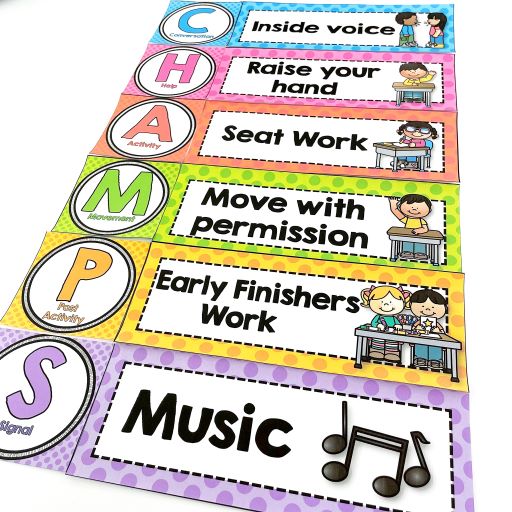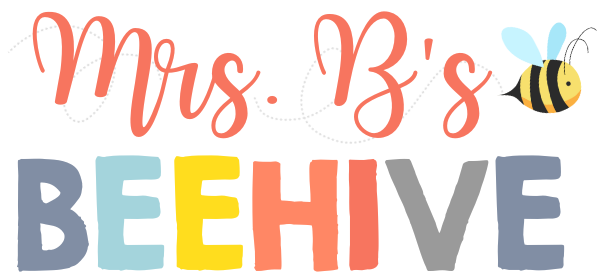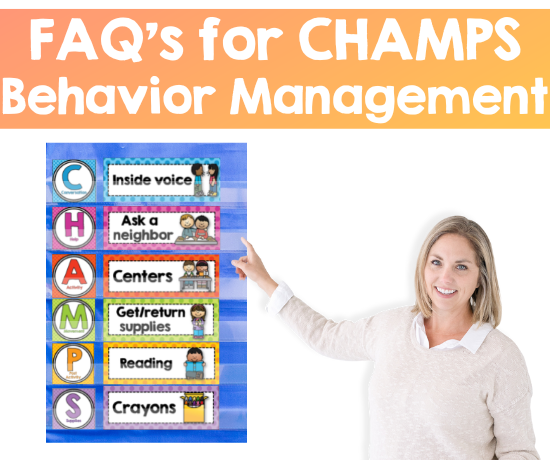Today I want to discuss some alternatives to using a clip chart Listen, I used a clip chart for YEARS and didn’t think much about it. Did it work for some students? Sure. Did it do anything for my really difficult behavior problems? Nope. As the years went on I relied less and less on the clip chart. I mostly used it to point out positive behavior and reward students who were consistently making good choices.
Now, after doing my research, I understand the harm that can be done by public attempts at individual behavior labeling. Besides the public shaming aspect, I know there are a lot of other more effective options out there for behavior management. Today I’m sharing a few alternatives with you that I hope you find useful in your classroom.
Setting up Expectations
About 7 years ago I had the worst-behaved class of my life. No matter what I tried I couldn’t get them to listen. That year I really started to dive deep into behavior management systems, and I learned about CHAMPS. CHAMPS is all about setting up expectations prior to an activity.

I have a post that goes into detail about the CHAMPS program if you would like to read it here:
CHAMPS Behavior Management
Whether you use the CHAMPS system or not, setting up clear expectations about the following things is crucial before students begin work:
- Expected voice level
- What to do when they need help
- What to do after their assignment is done
- How bathroom and water breaks are handled
- The movement that is allowed around the classroom
Look at the end of this post for an expectation FREEBIE that you can use with your class!
Explicit Teaching
Taking the first six weeks of school to explicitly teach expectations can be arduous. It’s tempting to skip over this part, but the work you put in at the beginning of the year will pay off.
Teaching all the (seemingly endless) routines you need to can be daunting. Check out this freebie I made that lists procedures taught during the first few weeks and add on to it as needed:
Teaching Procedures
On top of teaching procedures like – what to do when your pencil breaks or what the classroom should look like at the end of the day, you also need to explicitly teach behavior expectations.
Much of my read-aloud and social studies time in the first few weeks is spent reading stories that directly relate to the desired behavior. We follow it up with a discussion on what that behavior looks like in our classroom
I’ll read The Recess Queen for example, and then we’ll talk about how to play nicely on the playground. We’ll read My Mouth is a Volcano and talk about how we raise our hands to speak and listen when others are talking.
If you are looking for some other back to school reading recommendations, check out this post:
Back to School Read-Alouds Your Students Will Love
During this time I heavily praise students when I see them exhibiting the desired behavior. I’ll talk about how that individual really listened to a particular story and is showing me the behavior I would like to see.
Whole-Class Goals
Whole-class goals are the key to a solid behavior plan. The awesome thing about whole-class goals is that they can be modified to anything you would like to work on. With some of my classes, we’ve really needed to work on our carpet time stamina. Some classes can’t last five minutes without wiggling or touching each other. For other classes, we needed to work on cleaning things up properly after centers. Every year comes with its own set of challenges.
When utilizing whole-class goals, you need to clearly state the goal and paint a picture of what success looks like. Coming up with an idea for a reward together is also very motivating. I love these classroom management bingo cards from Teach Create Motivate’s TPT store:
Classroom Management Bingo
Once you have accomplished your goal together, you can move on to whatever new skill needs to be addressed. You can even have more than one goal going at a time. I probably wouldn’t do more than 2, but you could have an academic goal and a behavior goal that you are trying to reach simultaneously.
Individual Behavior Management
There are many options for individual praise. I love to use reward tags for academic, behavior, and developmental goals. You can check them out with the link below.

Reward Tags for Kindergarten
When a student is misbehaving I don’t ever use a one size fits all consequence. What really changed my mind about this was the increase of students on the autism spectrum in my class.
Each form of autism is so different and the reasons behind a child being triggered into undesirable behaviors are varied. My autism students really taught me that every behavior case needs to be handled differently whether a child is neurodivergent or not.
Sometimes student discipline problems arise because of learning delays, a situation at home that is affecting the child, lack of sleep, sensory sensitivity, or a million other things. The reasons behind behavior issues are so varied. A child just deciding not to listen is rarely the issue.
I’ve learned to recognize issues before they get too large (which I understand comes with more experience in the classroom). The key is knowing each child individually, their motivation, and their needs.
For most discipline issues I can have a one-on-one chat with the student, give them some time to cool down, and we’ve avoided an issue. Some incidents will result in the loss of a privilege or a conversation with a parent, but I really try to have an understanding of the WHY behind a behavior before I react.
To Sum it Up
Are you a bad teacher if you use clip charts? Absolutely not. I do hope that you’ve learned some useful tips today in terms of classroom management. We all learn and grow as we teach through the years. Our teaching philosophies and styles change as we grow in confidence, and that’s one of the beautiful things about this profession! Drop me a note in the comments below, I would love to hear your thoughts on clip charts, and how your teaching style has changed over the years.
Also, to help you set clear expectations with your students feel free to download these hand signal cards. Never have another lesson interrupted again with a potty emergency : ) Fill out the info below to grab the freebie!






